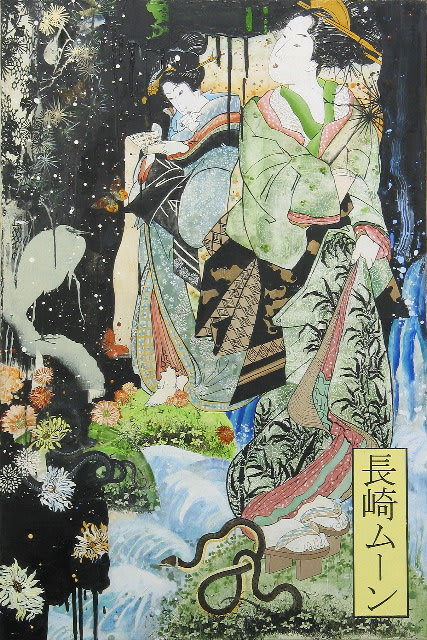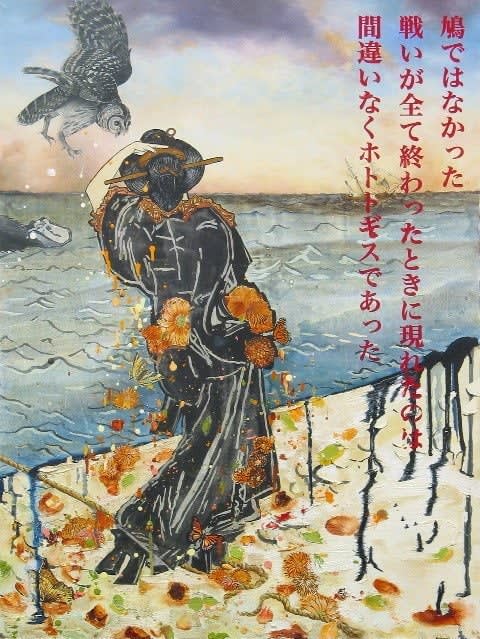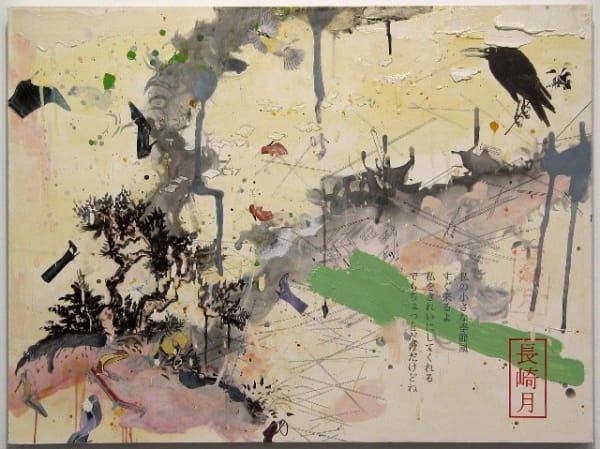Catherine McCarthy: That tiny ember of rage flared bright and on dry regrets caught hold
In the past 5 years, Boston-based painter Catherine McCarthy’s life-long fascination with Japanese woodblock prints has emerged as the primary influence on her paintings of layered and appropriated imagery of self-discovery.
This series of paintings follows the journey of the artist’s alter ego, the geisha Nagasaki Moon. Enfolded in multi-layered kimonos, the color and pattern of each signifying season and status and obscuring what lies beneath, Nagasaki Moon makes her modest journey through the psychic geography of her quest. Traveling stoically through winter landscapes and across stormy seas, Nagasaki Moon’s trials come by water, the age-old signifier of purification.
In several paintings, the tsunami batters her with cultural expectations or the monsoon purges her of the clutter of the world. In another, Nagasaki Moon opens her lips in speech and is surprised by an outpouring of storm-tossed surf. The ocean upon which she has cast her fate was within her all along.
Stylistically, the paintings are a melding of traditional Japanese prints, the late nineteenth century paintings of Whistler and Manet, and the gestural brushwork of the mid-twentieth-century artists Franz Kline and Robert Motherwell (who were themselves looking to the art of calligraphy). As a group, they form an open-ended psychological narrative as complex, sensual and rich with nuanced meaning as the layers of Nagasaki Moon’s garments.
-

-
![CATHERINE MCCARTHY "Enough is Enough (Song without Words)" [working title], 2005 oil and acrylic on canvas 40 x 30 inches 101.6 x 76.2 cms](data:image/gif;base64,R0lGODlhAQABAIAAAAAAAP///yH5BAEAAAAALAAAAAABAAEAAAIBRAA7)
-

-
 CATHERINE MCCARTHYGlint, 2005oil and acrylic on canvas35 x 53 inches
CATHERINE MCCARTHYGlint, 2005oil and acrylic on canvas35 x 53 inches
88.9 x 134.62 cms -
 CATHERINE MCCARTHYGreener Yet, 2005oil and acrylic on canvas53 x 35 inches
CATHERINE MCCARTHYGreener Yet, 2005oil and acrylic on canvas53 x 35 inches
134.62 x 88.9 cms -
 CATHERINE MCCARTHYNot the Dove, 2005oil and acrylic on canvas40 x 30 inches
CATHERINE MCCARTHYNot the Dove, 2005oil and acrylic on canvas40 x 30 inches
101.6 x 76.2 cms -
 CATHERINE MCCARTHYWe Have Always Lived in the Castle, 2003acrylic and oil on canvas60 x 80 inches
CATHERINE MCCARTHYWe Have Always Lived in the Castle, 2003acrylic and oil on canvas60 x 80 inches
152.4 x 203.2 cms -



![CATHERINE MCCARTHY "Enough is Enough (Song without Words)" [working title], 2005 oil and acrylic on canvas 40 x 30 inches 101.6 x 76.2 cms](https://artlogic-res.cloudinary.com/w_600,c_limit,f_auto,fl_lossy,q_auto/artlogicstorage/hosfeltgallery/images/view/28f4fd9e9a127b16bc5b285ac36867e42b95a423/hosfeltgallery-catherine-mccarthy-enough-is-enough-song-without-words-working-title-2005.jpg)





